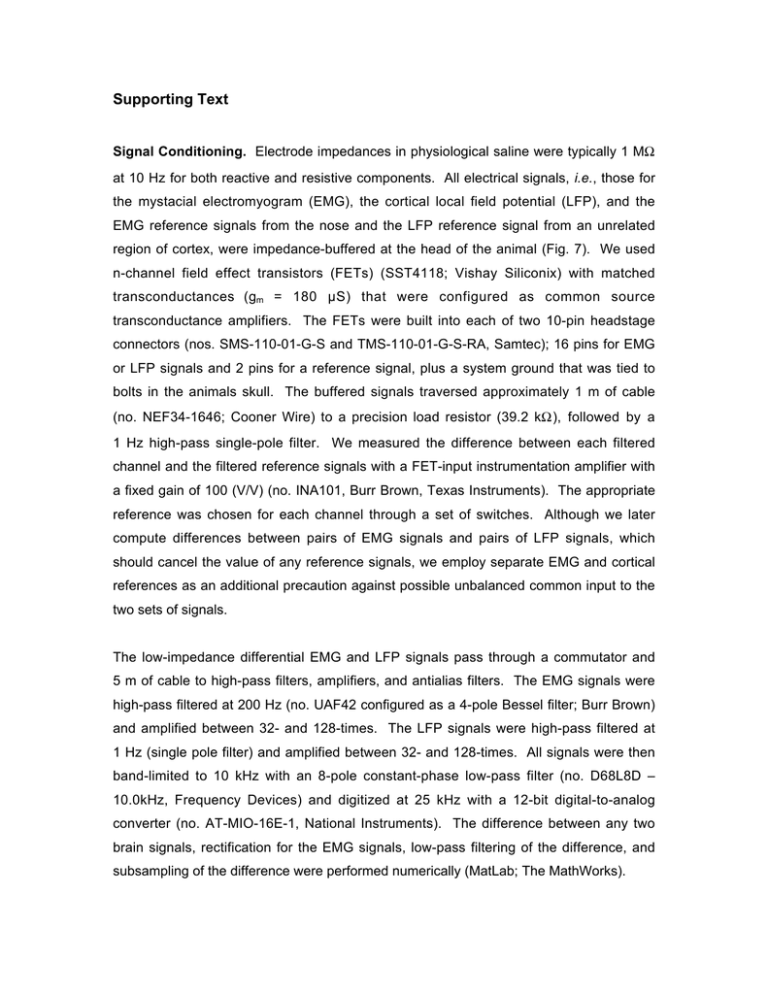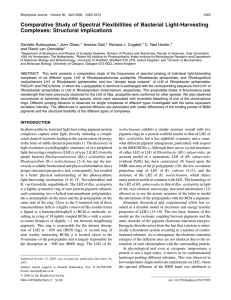Supporting Text
advertisement

Supporting Text
Signal Conditioning. Electrode impedances in physiological saline were typically 1 M!
at 10 Hz for both reactive and resistive components. All electrical signals, i.e., those for
the mystacial electromyogram (EMG), the cortical local field potential (LFP), and the
EMG reference signals from the nose and the LFP reference signal from an unrelated
region of cortex, were impedance-buffered at the head of the animal (Fig. 7). We used
n-channel field effect transistors (FETs) (SST4118; Vishay Siliconix) with matched
transconductances (gm = 180 µS) that were configured as common source
transconductance amplifiers. The FETs were built into each of two 10-pin headstage
connectors (nos. SMS-110-01-G-S and TMS-110-01-G-S-RA, Samtec); 16 pins for EMG
or LFP signals and 2 pins for a reference signal, plus a system ground that was tied to
bolts in the animals skull. The buffered signals traversed approximately 1 m of cable
(no. NEF34-1646; Cooner Wire) to a precision load resistor (39.2 k!), followed by a
1 Hz high-pass single-pole filter. We measured the difference between each filtered
channel and the filtered reference signals with a FET-input instrumentation amplifier with
a fixed gain of 100 (V/V) (no. INA101, Burr Brown, Texas Instruments). The appropriate
reference was chosen for each channel through a set of switches. Although we later
compute differences between pairs of EMG signals and pairs of LFP signals, which
should cancel the value of any reference signals, we employ separate EMG and cortical
references as an additional precaution against possible unbalanced common input to the
two sets of signals.
The low-impedance differential EMG and LFP signals pass through a commutator and
5 m of cable to high-pass filters, amplifiers, and antialias filters. The EMG signals were
high-pass filtered at 200 Hz (no. UAF42 configured as a 4-pole Bessel filter; Burr Brown)
and amplified between 32- and 128-times. The LFP signals were high-pass filtered at
1 Hz (single pole filter) and amplified between 32- and 128-times. All signals were then
band-limited to 10 kHz with an 8-pole constant-phase low-pass filter (no. D68L8D –
10.0kHz, Frequency Devices) and digitized at 25 kHz with a 12-bit digital-to-analog
converter (no. AT-MIO-16E-1, National Instruments). The difference between any two
brain signals, rectification for the EMG signals, low-pass filtering of the difference, and
subsampling of the difference were performed numerically (MatLab; The MathWorks).
Spectral estimates. Spectral methods provide a means to characterize the response
and the variability in that response as an average across trials. Spectra power densities
of individual epochs, denoted S(f), were calculated with the direct multi-taper spectral
estimation techniques of Thomson (1, 2); this procedure minimizes the leakage between
neighboring frequency bands. We denote the measured time-series for the i-th trial,
either "EMG or "LFP, as V (i) #
T
{V (i) (t)}t=0
where T is the duration of the epoch. The
mean value is removed from V(i) to form $V (i) = V(i) -
!
T
0
dt V(i). We compute the spectral
power in terms of an average over all instances and tapers, i.e.,
˜ (i,k)V˜ !(i,k)
S(f) # V
•••
where
•••
!
1
NK
refers
" "
N
K
i=0
k=1
to
averaging
over
independent
realizations,
i.e.,
and
{
}
V˜ (i,k) # V˜ (i,k) (f)
fs / 2
f=0
=
1
fS
#
T
t=0
ei2 !ft"V (i) (t)w(k) (t)
is the discrete Fourier transform of the product of the mean-subtracted time-series, $V(i),
with the k-th Slepian taper, w(k) #
T
{w(k) (t)}t=0 .
The parameter N is the number of
instances of the waveform and K is the number of tapers in a given spectral estimate.
The spectral coherence between pairs of time-series, denoted C(f), is defined
analogously to the spectral power, with
C(f) #
˜ !(i,k)
V˜ (i,k)U
S V (f)SU(f)
˜ (i,k) are the Fourier transforms of the two respective time-series. In
where V˜ (i,k) and U
these estimates, the spectrum is averaged over a half-bandwidth of %f = (K+1)/(2T); this
˜ (i,k) are
value ranged from 2.5 to 3 Hz in the present studies. Numerically, V˜ (i,k) and U
computed as the fast Fourier transforms of the respective product after it is padded to at
least 4-times the initial length.
Standard deviations of the spectra are reported as jackknife estimates across all
degrees of freedom (3).
Interpretation of |C(f)|. We consider a model that relates a signal y(t) to an underlying
variable x(t) by the convolution y(t) =
#
t
-"
d! T(t-&)x(&) + '(t), where T(t) is the linear
transfer function, x(t) is considered as a random variable, and '(t) is an underlying noise
()
source, with zero mean, that is uncorrelated with x(t). In the frequency domain, y! f =
() ()
T! f x! f
+ !˜ (f ) .
()
() ()
T! f
2
()
x! f
The spectral power in the signal is Syy(f) =
()
y! f
2
=
Sxx f + ! f where iii refers to averaging over all degrees of freedom, Sxx(f) =
2
is the power in the underlying variable and ((f) =
!˜ (f )
2
is the noise power;
we make no assumption about the spectral content of the noise. Similarly, the cross
()
()
spectral power between y! f and x! f
()
() ()
() ()
= T! f Sxx f . Recalling
is Syy(f) = y! f x! * f
()
()
that the coherence between y! f and x! f is defined as C(f) = Syx f
()
we have Syy(f) = C f
2
() ()
Syy f Sxx f ,
() ()
Syy f + ! f . Thus the ratio of the variability in the measured
'1
!
2$
signal to that in the underlying noise is Syy ( f ) !(f) = #1 - C(f) & . This expression is
"
%
analogous to the variability captured by the square of the correlation coefficient, r, in
2
regression analysis (4), where |C(f)|2 within a defined spectral band plays the role of r .
The spectral power in the underlying variable beyond that in the noise, which forms a
signal power, can be used to define a “Signal-to-Noise” ratio in a given frequency band
for the above model of noise, i.e.,
Signal-to-Noise #
Syy ( f )! "(f)
"(f)
=
C(f)
2
1 - C(f)
2
.
When |C(f)|2 << 1, as occurs for the measured data in this study (Figs. 3C and 5C), the
above expression simplifies to
!
C f <<1
3$
Signal-to-Noise !"( )"
" " |C(f)| + O# C(f) & .
"
%
Thus the reported magnitude of the coherence may be interpreted as a signal-to-noise
ratio for predicting vibrissa position, i.e., the "EMG, from the cortical signal, i.e., the
"LFP.
Caption
Figure 7. Abbreviated schematic of the recording electronics.
References
1.
2.
3.
4.
Percival, D. B. & Walden, A. T. (1993) Spectral Analysis for Physical
Applications: Multitaper and Conventional Univariate Techniques (Cambridge
University Press, Cambridge).
Thomson, D. J. (1982) Proceedings of the IEEE 70, 1055-1096.
Thomson, D. J. & Chave, A. D. (1991) in Advances in Spectrum Analysis and
Array Processing, ed. Shykin, S. (Prentice Hall, pp. 58-113.
Mardia, K. V., Kent, J. T. & Bibby, J. M. (1979) Multivariate Analysis (Academic
Press, San Diego).




